YAGI ANTENNA

Sounds like a movie title doesn't it? It seems since the advent of computer software primarily Eznec, there are legions of relatively new experts all claiming to have a better way to build a Yagi antenna. Some of these are quite good actually, and some will have you making something that half way through building it your going to be wondering why you got into this hobby in the first place. Just to reiterate I like Yagi antennas and in most conditions they do a wonderful job of getting you to places you will never be able to talk and listen to. Most Yagi antenna are quickly built yagi antennas. However some Yagi antenna fans not content to sit on their laurels ( and why should they? ) have been busy coming up with scheme's to build a better antenna. Now let me say this: Alot of these Eznec experts (I do really mean they are experts) I speak to quite frequently either through email or on the phone. And I frequently even buy their designs and try them out myself! And I am certainly interested in all antenna designs that will affect my own primarily HF recieving performance. However:

Doesn't this look fun to build? maybe on 432 mhz and when you have alot of time on your hands, and even more to model it. No thanks.
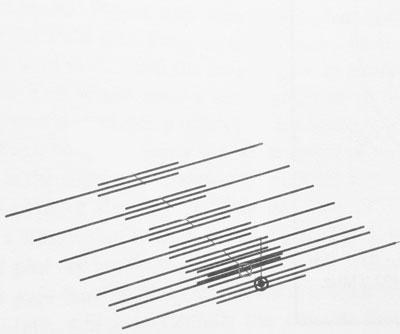
Or how about this one? Lots of elements surrounded by smaller ones? let's turn a 8 element yagi antenna into a 24 element yagi antenna! Why not! All of this and believe me there are many more designs that are based on the same principle........ Turn a single yagi beam into a stacked version (normally two yagi antennas) without building a whole nother yagi antenna. If you are familiar with Eznec you have noticed that these designs are trying to accomplish the same thing, isolate two yagi horizontal sections by providing a way to kill the radiation in the mid section of the antenna. In effect build one yagi antenna with the gain properties of two stacked yagi antennas. If even they are not exactly stacked at a long enough distance, or are compromised a bit on the bandwidth. What does this sound like?? And what is the visual description of what they are trying to accomplish? Have a look below.
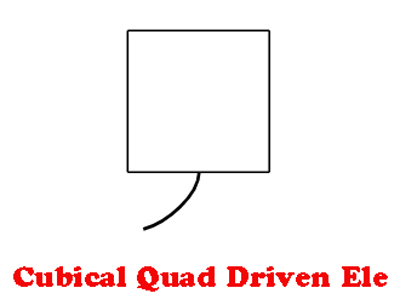
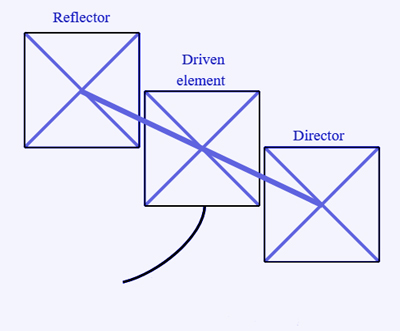
But wait a minute, thats a Cubical Quad ! Correct
! Yagi antenna experts have for years complained that the Cubical Quad was just
two 1/2 wave elements stacked one above the other. Thats right it is. Has anyone ever complained having two stacked yagi's?
So what's wrong with having two stacked antennas?? Apparently nothing
nowadays, as long as we call it a (place name here)Yagi antenna.
My point is, all of these designs are trying to accomplish the same 1 -
1.8 increased DB gain as the Quad. So I ask you? Which looks simpler to
build? The designs shown at the beginning of the page or the Quad shown
directly above? Some of these newer yagi designs use elements that are a
1/2 wave long or longer, for increased gain. Sounds good, but do you
really wanna build one of these? Especially on HF? Really?
Again I am not deriding anyone's work in antenna design, lord knows I have made my share of design Edsel's over the years.
But adding unnecessary complexity, weight and not to mention trying to
accurately match these designs in the REAL World.
I just don't see much benefit for the extended effort involved.
The Monobander:
3 - 4 - 5 - 6 elements placed on a boom, correctly spaced, correctly sized, correctly fed with coax in one spot for ONE band. The driven element. Does this give you 50 ohms? No it does not. Here you will have to have a balun or a matching device such as a Beta or Gamma match. A very simple antenna to build and put together. How does it work? Even with the very small match needed to bring 25 ohms up to 50 ohms for your coax, they work great. They have the highest gain of any yagi antenna you can build. Period. Forget what voodoo the manufacturer tells you, nothing beats a Monobander for a Yagi antenna. They are second to a cubical quad as far as being the highest gain antenna you can buy or build.

The Long Boom Trapped Tribander:
These work well as the traps do not have that much loss. The other small issue is this, since they are a fixed boom length, the spacing between the elements is the same. They are usually built as if they were comparable to a 15 meter monobander in size. Lets take a 4 element Tribander: The boom length lets assume is 24 feet. Four elements spaced 8 feet apart is almost the correct spacing for 15 meters, a little short for 20 meters but not bad, but very long spacing for 10 meters. As a result the 10 meter gain will suffer and most likely the SWR curve will not be a flat as 15 and 20 meters. The longer boom helps a bit on 10 meters but it is not correctly spaced, so its gain, f/b ratio and swr all will not be near optimum. Certainly less gain then the above. Depending upon the trap quality it could be alot less.
For those of you that multiplied 4 X 8 and got 32 foot boom, No my math is not wrong:

The Steppir and UltraBeam/Wimo antennas:
These antennas have a fixed Boom Length for all elements, same as the above, however here is no matching device, since the steppir motor will adjust the elements so that they have the correct length for a close to 1:1 SWR ratio. So you have eliminated any trap loss, but you still have too long a boom (in this size) for 10 meters. So although 10 meters on a Steppir/UltraBeam will show 1:1 swr, the antenna is still not properly sized, so your still missing out on some higher gain and a good F/B ratio compared to a properly spaced 10 meter monobander. These antennas are still a compromise, but for most amateurs who think SWR is everything, these settle their nerves a bit, until the steppir motor breaks! Gain wise they work very well, better most times then trapped antennas, but it depends on the boom length you choose and the spacing design. If you live in the northern part of the U.S. or anywhere in Canada you might want to reconsider these as you are asking alot from the Steppir motors. I personally have had 4 of the Steppir yagi antennas and had no issues with them. But I have heard from other amateurs about Steppir motor breakage and issues in freezing weather.
The Short boom Trapped Tribander:
These are very similar to the longer boom antennas, except that they are shorter. Typical lenght is a 14 foot boom lenght with traps. These have the same issue as the Stepped motor types and the longer boom tribander, except now 10 meters is the correct spacing and 20 meters is way too short. Here you have 10-15-20 meters all on a 14 foot boom! These of course are very popular, they are reasonably sized and you can get 3 bands, sometimes even 5 bands on them. However on 20 meters these antennas will not be as good as the longer boom tribanders or Steppir types, but will still work fine. The manufacturer db gain figures on antennas this short are not to be believed. Boom Length is what gives you db gain. Not much else. Period. If the antenna is correctly spaced on the band you wish to work, then the gain will be a bit higher and the Front to Back ratio will be better and the SWR will also be lowest.
The Overlay or Open sleeve no Trap Multibander:
What the heck does open sleeve mean? Well since the dawn of the trapped antenna in the late 1950's, other manufacturers of non trapped types have been bad mouthing them. This and the fact that most people in the world would like their technology to be smaller. Another way to make antennas smaller, and still multibanded had to be invented. Enter the overlay antenna. Rich N6KT experimented with these in the early 1990's. At first they had multiple feed lines, until computer software experimenting and a great deal of trial and error produced a single coax feedline in a trapless tribander, this was called the C-3 by Force-12 antennas and N6BT. This was also known as the open sleeve feed system. It was good for 10-15-20 meters, and with a tuner you could even get 12 and 17, even though you had NO 12 or 17 meter elements on the antenna ! Although the gain on those bands wasn't great. All on a 12 foot boom! Tom N6BT has a great book out about antennas called "Array of Light" where you will learn about his trials and tribulations of making these antennas.
It was all about the SWR match. Which is what most amateurs only care about after putting up a antenna. Bingo good SWR is all you need for a great eham.net rating. In effect what was happening was changing the lengths of elements, spacing or interlacing and overlaying the elements to achieve a close to 50 ohm impedance for a single feed line without traps. As these became more complex and other designs were built open sleeve became closed sleeve (feeding more than one element) and combinations of both designs in antennas appeared. It seems there was no end to these designs and what you could achieve with a masters degree in computer software. But Alas....... What about the gain? These type antennas perform as well as their boom is long. Most of them are of shorter boom types, to please the general amateur radio community. Who wouldn't want 6 bands all on a 14 foot boom, with db gain figures that rival the competitors claims?
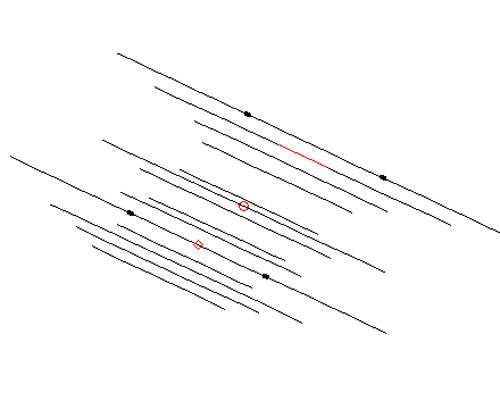
Do these antennas work? Yes they do, will they out perform a Mono bander of 4 elements on any band with the same boom length? NO. To get close to 50 ohms for a feedpoint alot of mystery length elements have to be arranged close to one another, this means less elements per band most times with the same boom length as a single mono bander antenna would have. It does have the benefit of not having any traps. So you don't have the maintenance that they do. This is the selling point, mono bander performance in a shorter non-trapped design. Don't believe it. These antennas usually have square booms, because the elements have to be perfectly aligned to get near the 50 optimum feed line impedance. There can be no movement of elements, they are usually made with thicker aluminum and are quite rugged and heavy to maintain the distances properly. If having all 5 bands on a yagi, reasonable SWR and no traps on a 12 - 21 foot boom appeals to you, then you have found your antenna. Personally you could build a Cubical Quad get better performance and be much lighter, without worrying so much about exact distances between elements, and you'd be ahead in the db gain department as well. However for some, a cubical quad seems like a bit of a headache, so here's your alternative in multiband short boom antennas without traps.


Linear Loaded Antennas.......Very similar to Open Sleeve and Closed Sleeve Designs
You have seen many of these antennas by now, most major manufacturers of yagi antennas have a version of them. Originally developed as VHF/ UHF antennas. Although the diagram above looks extreme, the antennas themselves are easy to pick out. Short elements shortly before or after longer elements. So what the story here? Is this the end of traps? Actually no. Although the linear load assembly on the elements requires extemely precise care, once assembled, it is almost as carefree as a full size multi-element Yagi. And it probably (although not always) has a better front-to-back ratio then a standard yagi ! Well here's the other side of the coin , you will lose at least a full db in gain at minimum, depending upon the size of the two elements trying to become one, and since these are generally used on shorter booms and on multiband antennas, the actual number of elements used on each band on these antennas, tends to be 2 - 3 elements tops. And again the spacing or distance between elements is fixed and not optimal spaced. Another large drawback is the narrower usable bandwidth. These antennas tend to have narrow bandwidth per band (since the elements are not properly sized or spaced from one another). You cannot change the law of Physics. Shorten any antenna by any means and you have compromised the optimum length, therefore affecting all of the attributes: db gain, bandwidth, swr curve, f/b ratio. Its the same issues the above open sleeve designs have, just fed for 50 ohm impedance in a different manner, thats all.
Manufacturers have even discovered that by placing different sizes of aluminum next to one another they not only can make the antenna and the elements shorter, they can also give you bands that don't actually have a driven element! In other words give you 12 or 17 meters, when in actuality there are NO aluminum pieces on the antenna that near 12 or 17 meter lengths. Phantom elements! Yup! And you thought just todays political correctness and cancel culture was a problem! Sometimes manufacturers will claim 8 db or something similar for these linear loaded shortened antennas. What they neglect to tell is that will be for only ONE band, while the rest of the antenna radiates closer to a single element dipole then a multiband / multielement yagi which is why you bought it in the first place. The manufacturers will quote the number of elements like 9 or 11 to sound impressive, when in reality your buying a antenna that is only one or two elements on each band.

The above antenna is advertised as a 7 element beam, covering 6 - 20 meters all on a 10 foot boom! Including the CB band ! With a dbi gain of 8.2 Sounds great right? NO NO NO Stay Away. For the above sometimes you hear the term para-sleeve loading or a para sleeve antenna. Instead of linear loading, its very much the same deal. NO.
Traps are an attempt by manufacturers to make shorter antennas by using wire wound around and non metallic cylindrical tube just below the resonant frequency of the desired frequency. This was invented by Mosley antennas so they can make shorter multiband antennas. The first trap is the highest band, and a bit farther out on the antenna will be the band slightly lower then that, and this continues until the last trap which is the lowest in frequency band needed. Generally no more then 3 traps are used on one antenna radiator...HENCE : The Trapped Tribander. Some amateurs hate traps and they have a controversial reputation. But should they? One reference claims that trapped tribander antennas with booms up to 25 feet long are no better then a half wave dipole THIS IS BLATANTLY FALSE. Another reference that one Specific manufacturer of trapped antennas (Mosley antennas) is terrible and all their antennas are poor performers. THIS IS BLATANTLY FALSE. So how efficient are they? It turns out that depends on the traps the manufacturer uses. My experience with antenna traps (I have had Mosley, Hygain, Cushcraft and several other brands), is they do require maintenance, some bugs and dirt will get inside of them and that with the weather over time will degrade their performance. But how efficient are they you ask again? Turns out pretty efficient overall. I can verify traps made by Mosley antennas and Hygain antennas are very good overall. If you are using any Yagi antenna from 17- 80 meters, mostly likely it is not full size and uses some sort of traps or linear loading or some other neato sounding advanced buzzword to make up for the shortened elements that you are using. Don't worry about Traps they are for the most part efficient. They will require periodic maintenance once in a while and don't blast them with excessive wattage and you'll be happy with them. Mosley and HyGain Antennas are good examples of quality trap antennas, no matter what you've read.

How they work and don't worry about loss
How does a trap work? First things is you must remember this you are pumping AC current into your antenna. AC current is another name for RF. Circuit components such as capacitors and inductors can CHANGE the way RF (ac current) behaves. This is the basis of all electronics. 20 meters is AC current oscillating back and forth or up and down in one cycle if you prefer, 14 Million times per second. Electronic circuits can change the way this particular (14 mhz) AC current behaves once it hits a capacitor or and inductor for instance AND this is exactly what happens in the case of traps.
Traps consist of two circuits a capacitor and an inductor. If you open a trap you will see a coil wound around a non conductive material. This is the inductor part of the trap. The metal housing surrounding this inductor is actually the capacitor part of the trap. So lets say you have a multiband antenna, whether a vertical or tribander it doesn't matter, all you know is that it has traps. Traps are built so that the (LC circuit) capacitors and the inductor will make the RF heading its way up from the beginning of the Vertical or horizontally from the center of the yagi heading towards the trap...... Think at that frequency of 14 Mhz as an example, that ..that is the END of the antenna! However any frequency lower than that, lets say 40 or 80 meters will continue past the trap and keep going to either the end of the antenna or to the beginning of the next trap. This means a 20/40/80 meter dipole has two traps on it. One which stops the 20 meter (14 mhz signal) from going any further, and one which stops the 40 meter (7 mhz signal) from going any further. The 80 meter RF (AC Current) continues to the end of the dipole with no other traps in the way. Trap antennas are shorter than normal non-trapped antennas, and this is one of their advantages, the other of course is you can have multiple bands on one antenna, fed with one piece of coax. Traps do have loss, but as you will see it's not so much the trap itself, but the shortening of the antenna which has alot to do with it.
TRAP LOSS
Thanks go to Roy Lewallen for his wonderful EZnec program, which helps give an accurate picture of trap losses
Without trying to get too complicated, here goes: With traps the big buzzword is "Q". The higher the "Q" the more efficient the trap is. Well built antenna traps made by the above mentioned manufacturers are of high "Q" design, and these should only have a loss of .1 to .2 db loss per trap versus and full length antenna radiator. So whats this "Q" all about. Basically the "Q" is the amount of electrical energy that comes into the trap versus how much comes out the other side. 100% in 95% out.... kind of analogy. You can even make traps out of coax wrapped around a PVC tube! However my experience is these coax traps do not have a very high "Q" (400), they are probably close to .5 db loss per trap versus a straight no trap full size dipole. But they do work. Are manufacturer made trapped antennas good antennas? My answer is yes. Now that doesn't mean you should believe any of the db claims in advertising anymore then you should believe anybody else's claims. Can trapped antennas provide more gain then non-trapped full size monoband antennas ? NO. Its not possible. Traps cannot increase gain only lose some of it. If you can put up a full size monobander and thats all you want at your location, by all means choose that over a trapped antenna. But if your like many amateurs and do not have room for lots of big antennas and or towers, then a trapped tribander or other trapped antenna type will work just fine. Can you get an idea of trap losses without depending upon software? Sure, grab a trap after putting some power into it after a few minutes of transmitting in the shack, and see if it got warm. This is where any losses will go. My bet is you won't even be able to feel any difference between it and the outside temperture. This indicates very minimal losses. So why do some people abhor them. Traps are like tuners, they DO have power ratings, maybe some people after much work finally put up their large tribander, and then decided to put A Gazillion watts through it. It blew up, they took it down and said " traps suck " . And that was that. I am sure that is some of it. Other amateurs invented different ways to build a shorter antenna with decent SWR and for whatever reason just hated traps. Maybe it's the word itself "Traps" or "Trapped ". Hmmm... I'm starting to not like them myself based on that word.
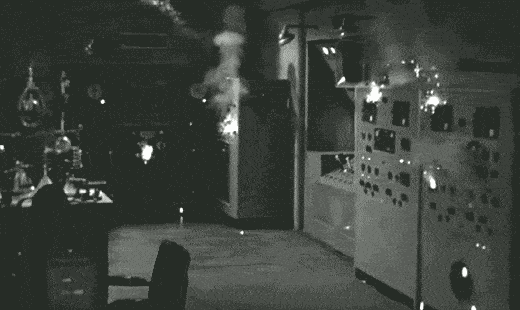
Other info touted is by amateurs building their own designs and therefore the "trapped" antenna becomes an easy target to pick on. What about those "tests" made by amateurs in that ringed booklet saying trapped antennas suffer from "blah, blah ,blah, etc, etc" and they should be avoided like the plague at all times by any manufacturer. What can I tell you? Traps are not that difficult to understand or build. They are basically similar to loading coils (with an added capacitor) and loading coils are used on virtually every HF mobile antenna. And nobody complains about them there. There is alot of anti-trap propaganda on the net, disregard it when deciding to purchase the multiband antenna that fits perfectly in your yard and allows you to use bands you don't have now.
Ok enough about traps, what about the Yagi antenna design evolution ?
I would default to EZnec as that can teach you alot about antenna design, but generally the Yagi design timeline looks like this:
1. For many years the Yagi antenna types were wide evenly spaced designs, matched with some type beta or gamma match.
2. Trapped designs came in that meant you could have multiple bands per antenna. Fed with one piece of coax usually.
3. Then basic computer programs showed that Yagi's could be matched with sections of 75 ohm coax runs to then get to a 50 ohm impedance.
4. Then you could eliminate any of this, by resizing the elements on the fly and get good SWR ( Steppir and Ultrabeam antennas)
5. Further computer advancements in modeling showed that monoband Yagi's could be re-spaced and resized to give good results while just using 50 ohm coax.
6. As more adventureous amateurs became involved with computer design, multiband designs came up with element spacings very close to one another to "create" 12 meters or other frequencys where no 12 meter or other frequency antenna driven element is even present! 7 bands, 15 elements all on a 11 foot boom all fed with one piece of 50 ohm coax. Will it work yes, will it su*k ?....I'll let you decide. Some of these have fantastic DB gain claims. Don't believe them. I DON'T
7. UHF experimenters claim the best Yagi's are ones with the lowest noise ( best front to back and front to side ratios ). And most of the above designs are immaterial because boom length is all that matters. Lowest noise meaning high F/B ratios, high F/Side ratios, and clean narrow frontal radiation lobes.
Admittedly it's tough to be a antenna manufacturer, especially a small one. Being somewhat of a software writing and antenna building geek myself. ( I know hard to believe! ) I personally speak to antenna manufacturers who a few years ago built beautiful high gain monoband yagi's, mostly of the longer boom type. We would talk about the newer open sleeve and other newer matching types for hours and how they are advertised to be as good as long boom yagi mono banders (*$@&*%(&*^% ). Now that same manufacturer a friend of mine, is making the very same antennas he railed against! Why... Well of course Money talks, and if those newer well advertised designs are selling, you better start building them before your out of business.
For me and what I have seen personally. I have used all of these. AND #5 and #7 gave me the best performance. Its tough to beat a properly spaced and tuned Monoband Yagi with any other Yagi "Improved" design like #6. Can you put lots of elements on a short boom yagi and get all bands with one piece of coax? Will it work? Yes, Will it come anywhere near a single Monoband Yagi of a similar or greater boom length? Absolutely Never. At least not now it doesn't. With these designs you end up with either smaller amounts of real elements, and every band winds up being the equivalent of a 2 or 3 element yagi at best (similar to a log-periodic antenna), because none of the bands are using the full boom length of the antenna only parts of it on any of the bands. When you could have had a 4 or greater element monobander or tribander trapped that works just as well or better. But Wait manufacturers say they work alot better then all of the other designs. Yeah. manufacturers and amateurs claiming to be manufacturers say alot of things. The jury is still out on them despite claims that they do.
The biggest difference in Antenna Gain in a Yagi Antenna or a Cubical Quad for that matter is boom length PERIOD. No matter what kind of computer designing the antenna designer or manufacturer told you, antenna boom length is the be all, end all of antenna db gain. This goes for Trapped Antennas, Open Sleeve Antennas, Linear Loaded Antennas, Para-Sleeve Antennas, Log-Cell Antennas, Monobander or Multibander Antennas of any type. If they don't increase the actual boom length of the antenna..... even when it has Pamela Anderson sitting naked on it, while its turning around in your backyard, it doesn't have any more gain! Now for me personally I don't care what an antenna is called. If a single monoband Yagi gave 1 - 1.5 more DB gain then a comparable Quad, I would using them no matter what you wanna call it. Yagi, Quad, Quagi, etc,etc. So be aware just like wire antennas, (see 140 varieties here) there are lots of Yagi antenna designs, some good, some ridiculously hard to build, some simple and some completely ineffcient. Antenna's are enough of a pain in the *ss to begin with, in my book I want something simple that works. You want the Best Yagi money can buy? get a long boom Monobander.

Last Updated: